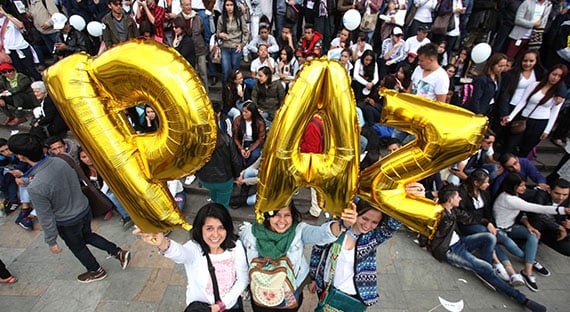
(photo: Abel Cardenas GDA Photo Service/Newscom)
Colombians celebrate in Bogotá. The peace agreement was signed on September 26, 2017 (photo: Abel Cardenas GDA Photo Service/Newscom)
Colombia's Peace Agreement Can Give Fillip to Inclusive Growth
May 31, 2017
The implementation of Colombia’s peace agreement, together with the government’s structural reform agenda, should help support more inclusive growth over the medium term, the IMF said in its annual assessment of the Colombian economy.
Related Links
Colombia—Latin America’s fourth largest economy—withstood multiple domestic and external shocks in 2016, yet achieved relatively strong GDP growth. The government reacted flexibly by steering inflation toward its target and by restraining fiscal expenditure, while protecting key social and infrastructure spending. These measures ensured an orderly, growth-friendly adjustment and helped bring down poverty and inequality further.
While further adjustment is needed, rapidly declining inflation will createroom for some lowering of interest rates during the year, the reportpointed out. And the approved tax reform will help generate revenues tolower the fiscal deficit while improving competitiveness.
At the same time, the implementation of the peace agreement will target existing gaps in infrastructure and basic services, and protect debt sustainability. The report expects peace to improve medium-term growth by up to 0.5 percent, and further over the longer term.
Fast Facts
- Population (2015): 48.2 million
- Unemployment rate (2015): 8.9%
- GDP per capita (2015): $6,048
- Life expectancy (2013): 73.8 years
- Adult literacy rate (2011): 93.6%
- Poverty rate (2013): 5.3%
For 2017, the IMF projects growth to gradually strengthen over the next five years as the economy steadily diversifies away from commodities. Future growth of about 3.5 percent will be supported by non-commodity exports, infrastructure spending, and improved confidence stemming from the peace agreement.
Regional differences
Colombia’s strong economic performance during the past decades masks important differences across regions, the report noted. On average, incomeper person expanded by 50 percent during 2000–2015. However, while the top 5 regions (departamentos) doubled their income per capita during that time, in the bottom 5 regions income per capita declined by about 13 percent.

Human capital differences are likely a contributing factor. While the national education attainment improved from 7 to 9 years (for people aged 15 or older), large differences remain, with a 3-year gap between the top and bottom region (Bogota and Vichada, respectively).
Elements of the peace agreement
The peace agreement with the Revolutionary Armed Forces (FARC, after the initials in Spanish) has a strong focus on rural development and social inclusion. The agreement aims to reduce gaps in education, health, infrastructure, and other public services among rural areas. It will also help people displaced by the conflict get back into agriculture activity, including through land reform.
The agreement also includes:
• financial incentives to replace illicit drugs with alternative crops and measures to reincorporate guerrilla members into society;
• tax incentives to firms that invest or relocate to regions affected by the conflict;
• special courts to handle conflict-related crimes and allows guerrilla members to compete for political positions; and
• an extension of the victims’ reparations program that started in 2011.
The implementation of the agreement—to take place over 15 years—will give priority to regions with the largest institutional and social gaps. Short-term priorities include municipalities with significant coca production, FARC presence, or lacking state presence. Other priority groups include municipalities affected by the conflict and those with low income per capita, where private participation is expected to complement government programs as in the southand west part of the country.
Making growth more inclusive
The peace agreement will cement security gains achieved over the last decade and continue to bring more investment to the country. The implementation of the peace agreement will also focus on the regions where income per capita is relatively lower. The delivery of basic public goods and services to remote, poor, and conflict-ridden regions of the country—in addition to Colombia’s improved security conditions—will certainly make growth more inclusive over time.



